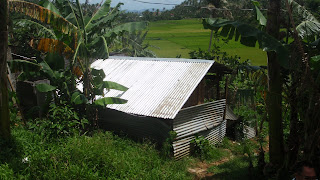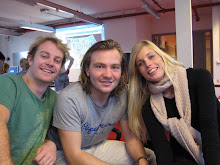Wednesday 11 and Thursday 12 March
We travelled to Lagazpi city early morning on Wednesday. We still have to get used to the daily routine here, because people tend to start their days really early! Schools start at 7 am, so people get up around 6. This is about the time when the sun comes up. We have noticed that this is true for most of our UE - case countries.
After arriving we were picked up by Rico Locaba, from Heifer, and introduced to Sir Felix Ador. He is the head of the Aquinas University Foundation Inc. We had a meeting with them and received a very warm welcome on the university campus. We were introduced to Father Ramon Mendez, rector of the university. He explained to us what the intention of the foundation was: a lot of students come from the provincial communities. The foundation brings the students and the education back into the communities so that they can learn from each other. Projects consist of for instance water engineering and typhoon mitigation, but there was an acting programme as well. This last example helps to empower the poor and develop their sense of confidence about the future. Two lovely rooms at the campus were made up for us.
After lunch we met with Cedric Daep, head of the PDCC (Provincial Disaster Coordinating Council). He was very enthusiastic about our research and said that this is exactly what is needed to develop long-term sustainable solutions. At the moment there are practically no maps at all. Albay is the only province with a separated pre disaster preparedness workgroup in the Philippines. (This task is normally incorporated within the post disaster workgroup, also called a (x)DCC, with (x) representing any scale of government) This seperation was the result of the three typhoons (of which Reming was the worst) that hit this province in 2006. The disaster was very complex: high wind speeds of up to 240 km/h, heavy rains, mudslides (Lahar's) from the Mayon volcano and different types of floods caused a massive destruction. After the typhoons, a quote 'typhoon of relief worker' s' engulfed the city. It seems that each NGO does it's work according to their own visions, not working together with government or each other and not reacting to local situations. Something we have to look in to...
Cedric gave us an example of this. The general conception of prevention of mudslides is to plant trees. However, in this case planting trees would only make it worse, because trees will catch heavy winds and shake and loosen the ground. This makes the ground more penetrable for water which will only increases the risk of Lahars. Some NGO's press for trees along the riverbanks to stabilise the earth, but when these trees fall over into the river, the water will not be able to escape. We conclude that disaster risk reduction is different in typhoon prone area's and that it is good that a man like Cedric Daep is in charge of the coordination.

Mt. Mayon is still very active and every now and then it deposits new rubble on the top. This will want to come down, and forms a potential risk for the surrounding barangay's (communities). One of the things he showed us on the map, was a clear circle of barangay's with a 8 km radius surrounding the volcano. These area's are all at risk. Even some resettlement area's are still at risk due to poor planning. The land here is very fertile and provides for what people here call livelihoods, a means of income. Resettlement area's often lack the land to produce foods. In Cedric's office we met with the local vulcanologist and he explained the Lahar principles to us. Basically, in his view, the whole of Lagazpi city is at risk to mudslides. The volcano is world famous for being perfectly cone-shaped, but this is simultaneously the same reason why the volcano is so unpredictable, the mud can flow of from each side. This news came as a bit of a shock to our escorts...
After that, Brother Raul and Floor, also connected to the AQFI brought us to Barangay Padang. This was one of the communities that was covered in mud and rubble after the typhoon. It was quite scary that we were actually walking on top of a large cemetery with many people and houses buried beneath the soil. The top part of a couple of the concrete structures were still visible. Some of the people had actually moved back to the site and started living there again. Admittedly this is a beautiful place, both at the foot of the volcano and on the sea shore. I can imagine why people would come back here.
The next day we were escorted by Brother Raul and Justin Cabrera, project manager of the CARESS Relocation Site in Legazpi city. We visited 5 different relocation sights this day, but this first sight definitely was the best, in our eyes. CARESS stands for City Assistance for the RElocation of Squatters and Slum dwellers. Originally this project was planned from Manila, covering the whole 3.9 ha. with plots. The plan was quite ridiculous, for half of the site was on a very steep hill. Through the work of Justin and others, the plans changed to incorporate a conservation park on the hill. Houses at the bottom have been, or will be transported a couple of hundred metres to saver locations. 98 plots have been laid out and materials provided. Water pumps have been placed. The people have built their own houses according to their needs and private gardens have been fenced. People grow their own foods in these gardens or on the conserved hill. Rice paddy's surround the site. In the coming months some infrastructual work will add concrete roads, stairs and drainage. This site resembled the traditional barangay's in the way people take care of themselves and build their houses.

Other site's were quite different. The main difference was the lack of difference. Other site's, most of them constructed by NGO's like Oxfam, Humanitas, etc. used one type of house (each NGO has an own type). This type was reproduced an x amount of times on a strict grid along paved roads. All basic needs were installed: water, sanitation, schools, communal space, but there was no space for agriculture. As a result people have to travel to the city to find work and spend a lot of money for this travelling. That was their main complaint about living in these places. Because of this, these site's resembled the mono-functional suburbs we know from the US or the VINEX from Holland. Nothing happened there... And on top of that the houses were suitable for a family of about 5, but when the families grow, they can not increase their living space, as they are used to do. Even though, we found small economic businesses: a sewing machine and a hair dressers in the back of one of these houses. The site's we visited were quite a bit larger compared to the first (except one). Here is a list: Taysan relocation site, Anislag (Daraga), St Francis of Assisi relocation site, Tagaytay (Camalig)

At the end of the day Brother Raul and Justin brought us to Smoke 'n Grill where we ate goat, snake and pig's face to accompany the SMG's (San Miguel Light). Page, a water engineer and American peace corps volunteer, joined us and advised to never order soup nr. 5. He has been here for 3 years and speaks the local Bicollano. He was able to explain what the different face expressions mean, like lifting eyebrows for yes and pursed lips combined with a certain direction for pointing at something. The night ended with a videoke session, as is the tradition here. Even in the poorest barangay's you will be able to find huge videoke (same as karaoke) installations.
The amount of life is so truly beautiful about the Philippines. Everything is full of it. The rice fields, the papaya trees, the bugs and bullfrogs, the eagles and lizards, the water, the people. There is a great understanding of this. Everything co-exists. That is why people will not steal from you, they would rather offer you some food. In stead of asking something like are you o.k., they will ask you: 'have you eaten' If you would ask about somewhere to sleep they will offer it to you. You have to be careful with your questions... This hospitality is something they are very proud of. If someone dies, the coffin will be placed inside the home for a couple of days and during this time everyone, even strangers, will visit and receive foods and drinks from the family. A poker table will be installed. Fun and Joy are celebrated every day, people love to make jokes, dance and sing. This is a very modest and beautiful country, it deserves to be up there with Thailand.


Geen opmerkingen:
Een reactie posten